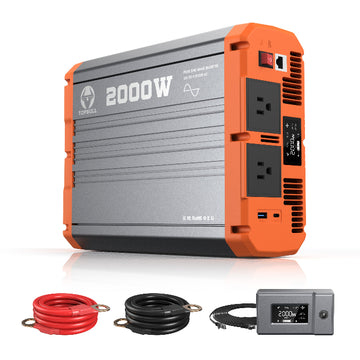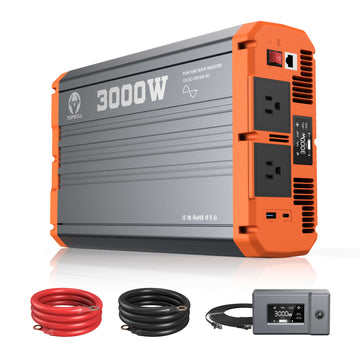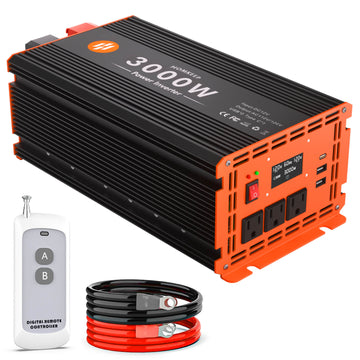Have you ever wondered how you can power your laptop, microwave, or TV while camping in your RV? While your RV's battery provides energy, most household appliances require a different type of electricity—this is where an inverter comes in.
An RV inverter converts the 12V (or sometimes 24V/48V) DC power from your battery into 120V AC power, allowing you to run essential devices just like at home. But what does an inverter do in an RV in your motorhome/camper, and which inverter is best for your needs?
In this guide, we'll explain the role of an inverter in an RV, how it integrates with your power system, and what to consider when choosing the right one. Plus, we'll share our top inverter recommendations to help you get the best performance on the road.
Overview: How Does an RV Inverter Work
Most RVs use a 12V battery system, though some models feature 24V or even 48V configurations. The battery stores DC power, which is used by lights, fans, and other DC-compatible devices in the RV. The battery is typically charged through solar panels, alternators, or external chargers.
However, many household appliances, such as microwaves, coffee makers, and traditional refrigerators, require AC (alternating current) power. Since DC flows in one direction while AC oscillates, an inverter is needed to convert the 12V DC into 120V AC to run these appliances.
An inverter allows you to operate home-like appliances while off-grid, making RV life more comfortable. Some high-capacity inverters can handle multiple appliances simultaneously, but they depend on battery capacity. For extended power needs, an RV generator can produce electricity independently by burning fuel, ensuring a continuous energy supply.

Types of RV Inverters: Which One is Right for You
Not all RV inverters function the same way. When considering what an inverter does in an RV, you also need to determine which type best suits your power needs. The two most common types are modified sine wave inverters and pure sine wave inverters.
Here are the key differences between them:
- Modified Sine Wave Inverters: These inverters generate AC power using a stepped waveform, which is an approximation of a sine wave rather than a true one. They are more affordable but can cause issues with sensitive electronics, medical devices, and motor-driven appliances. You may experience increased heat, noise, or reduced efficiency with certain devices.
- Pure Sine Wave Inverters: These inverters generate smooth and consistent AC power, closely mimicking the electricity from the power grid. They are ideal for running sensitive electronics, medical equipment (such as CPAP machines), and high-efficiency appliances. Although they are more expensive, they ensure optimal performance and longevity for your devices.
In short, whether you want to power laptops, CPAP machines, lights, or appliances with motors, a pure sine wave inverter will be the best choice to ensure efficiency and reliability.
What Can You Power with an RV Inverter
Now you've learned the role of a power inverter for campers or RVs. Let's explore the types of appliances an RV inverter can power. Your inverter's capacity determines which devices you can run, and a higher-wattage inverter, like a 3000 Watt Inverter, allows more appliances to operate simultaneously. However, the total power draw must stay within the inverter's limits and the available battery capacity.
Here's a general breakdown of what different inverters can handle:
-
Small devices (low-wattage inverters, 300W-1000W): Phone chargers, laptops, TVs, LED lights
-
Medium power appliances (1000W-2000W inverters): Coffee makers, small microwaves (up to 1000W), RV-specific refrigerators
- High-power appliances (requiring 3000W+ inverters and high surge capacity): RV air conditioners (with soft start), high-wattage induction cooktops
How to Pick the Best RV Inverter for Your Needs
Choosing the right inverter for RVs requires considering several factors. Here are the key things to keep in mind when selecting the best inverter for your RV:
- Power Requirements: Add up the running watts of all appliances you plan to use simultaneously. Also, check surge power requirements to ensure your inverter can handle peak loads.
- Battery Capacity: Your battery size determines how long appliances can run before recharging. Most RVs use deep-cycle batteries, so make sure your inverter's power draw aligns with your battery bank capacity.
-
Efficiency & Safety Features: Choose inverters with at least 85% efficiency, overload protection, low-voltage shutoff, and built-in cooling systems.
- Portability & Installation: Consider whether you need a hardwired inverter (for a permanent setup) or a plug-and-play inverter (which connects to a standard outlet). Always install it in a well-ventilated area to prevent overheating.
How to Calculate the Right Inverter Size
Here's a step-by-step example to determine the correct inverter size:
Example Setup:
Refrigerator 800W (2000W surge), LED lights (10 bulbs) 100W, TV 200W, Laptop 100W, Fans (2) 120W, and Microwave 1000W (2000W surge).
Calculation:
- Total Running Watts: 2,320W
- Inverter Efficiency (85-95%) Correction: 2,550W – 2,670W
- Maximum Surge Watts (Worst Case): ~4,000W (assuming refrigerator & microwave surge together)
Top Recommended Inverters for RVs (Best Pick)
Choosing the right RV inverter depends on your specific power needs. Whether you're running basic electronics or high-wattage appliances, TOPBULL's pure sine wave inverters ensure reliable and efficient power conversion. With built-in safety features, multiple outlets, and remote-control functionality, these inverters are designed for seamless RV use.
Why Choose TOPBULL Inverters?
TOPBULL inverters stand out due to their efficiency, reliability, and safety features. Here are the details:
-
Pure Sine Wave Output: The inverter provides a pure sine wave output, delivering smooth and high-quality AC power suitable for sensitive electronics such as laptops and medical devices.
-
High Efficiency: While specific efficiency percentages are not detailed in the provided information, the inverter is designed for stable and efficient power conversion, aiming to reduce energy loss and optimize battery performance.
-
Advanced Safety Mechanisms: The inverter incorporates seven protection mechanisms, including overload, over-voltage, under-voltage, high temperature, short circuit, leakage, and reverse polarity protection, ensuring secure operation.
- User-Friendly Design: Equipped with two U.S. standard AC outlets, USB and Type-C fast charging ports, dual LCDs, and a 16.5-foot wired remote control, the inverter offers multiple features for ease of use and monitoring.
Here are two top-rated inverters to suit different RV power requirements:
3000W Pure Sine Wave Power Inverter – Best for mid-sized setups
- Power appliances like TVs, laptops, small refrigerators, and microwaves
- Ideal for users who need moderate power with some high-surge devices

4000W Pure Sine Wave Power Inverter – Best for high-wattage needs
- Handles power-hungry devices such as air conditioners, induction cooktops, and large refrigerators
- Perfect for full-time RVers or those with extensive off-grid power needs

How to Install an RV Power Inverter (Step-by-Step)
Proper installation ensures your RV inverter runs safely and efficiently. Follow these key steps:
- Turn Off & Disconnect Power – Shut down shore power, solar panels, and batteries.
- Mount the Inverter – Secure it in a dry, ventilated space using brackets.
- Install a Fuse/Breaker – Place a correctly rated fuse within 18 inches of the battery's positive terminal.
- Connect to Battery – Use the right gauge cables, connecting the positive (+) terminal first, then the negative (-).
- Ground the Inverter – Attach the ground wire to the RV chassis for safety.
- Connect to AC Panel – If hardwiring, use a transfer switch to avoid conflicts with shore power.
- Test the System – Power on the inverter and check with a small appliance first.
- Secure Wiring – Use cable ties and conduits to prevent wire movement and wear.
Conclusion
Now that you have a clear understanding of what an inverter does in an RV, you also know the key factors to consider when choosing the right unit for your needs. For a hassle-free experience with reliable power conversion, choose from TOPBULL's pure sine wave inverters. These inverters are versatile, lightweight, and efficient, making them the ideal solution for any RV setup. Try them out and enjoy a new level of convenience and power reliability on your next adventure!











![How to Install A Power Inverter in A Truck [Best Guide]](http://www.topbullshop.com/cdn/shop/articles/How-to-Install-A-Power-Inverter-in-A-Truck.jpg?v=1743407247&width=360)

